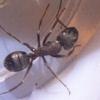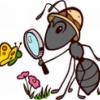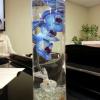I have successfully raised multiple Pogonomyrmex species over the years and I would be pleased to share what works for me.
First, here is 'what to do':
- Give the new queen a clean soil environment in a tank or enclosure large enough to provide both a temperature and moisture gradient. She can then choose the proper local environment necessary to raise the eggs up through pupae.
- Provide an overhead lamp (60 watt incandescent) with a 'bell' that can focus the light and heat toward one section of the top soil. Put this on an appliance timer set to go on at 7-8AM and off at 6-7PM. The eggs need exposure to higher temperatures than the larvae to incubate and hatch. Similiarly, the pupae are usually transported within an inch of the top soil after the lamp comes-on in the early AM. Within an hour of the timer switching the lamp off in the evening, the eggs and pupae will be transported to the lower levels of the nest until the next diurnal cycle begins. Having an appliance timer turning the lamp on and off every 10-12 hours provides a nice temperature gradient and simulates their natural environmental conditions. The top soil temperature should not get so hot you cannot keep your finger pressed to it for several seconds.
- Provide Poppy and Black Niger seeds. I buy the Poppy seeds in bottles from the spice section of my local supermarket. Last time I bought the 'Organic' McCormick brand. The Poppy seeds are small enough to be handled by the nanitics without any trouble. I ordered the Black Niger seeds on-line. They are larger but can be handled by the queen and larger workers produced later in the colony's growth cycle. Some Pogonomyrmex will readily accept grass seeds, but make sure you get untreated seeds that don't have a biocide/fungicide coating-this is obviously a critical factor in the choice of grass seeds. When I last bought some Kentucky Blue Grass seeds several years ago, I got them from an organic farm specializing in selling untreated seeds. Kentucky Blue Grass seeds are relatively small and can be handled by nanitics.
- Provide crushed-up dried insects. I use a blend intended for Bearded Dragons. (brand 'All Living Things' from Pet Smart). This is also an untreated product and consists of dried meal worms, grasshoppers and crickets. I break the insects down by crushing them between my fingers. Don't turn them into dust--just into smaller particals that can be hauled-off by smaller workers.
- Give them enough food that they can cart off in 10-15 minutes. If just providing food for a new queen, give her the same except you won't have to do it weekly. Place some Poppy and Black Niger seeds outside the lamp area so they won't get too hot. Pogonomyrmex queens that are facultative or obligate foragers will continue to periodically forage, so I always leave some seeds out. Again, put the seeds in an area that never gets water or is directly under the lamp.
- Add filtered water in small amounts to the soil away from the lamp that can slowly percolate down 1-2 inches; about once every two weeks. The ants will store their seeds and other food near the surface under the lamp-which is to be kept moisture-free to prevent mold and spoilage. If you recently set-up your enclosure with moistened soil, you won't have to add water until the soil starts to dry-out on its own.
- Provide fresh, filtered water in an inverted medicine bottle top imbedded flush to the topsoil. Use the type that is very thin and about the circumference of a quarter. Add some sand and/or very small rocks to allow workers that have entered the cap to climb-on and not drown. Fill this up with water 1-2 times a week. Even if you forget to water the colony for a few weeks, they can get the water they need to survive by drinking it from the cap. They may eventually fill-up the cap with soil and stones, so some maintainance may be required.
- Provide the above-mentioned food to every natal nest, even if the queen is fully claustral. If you try to raise fully-claustral queens without food, the mortality rate will be much higher than if you do provide food. Why test the limits of her ability to use stored fat and protein to raise brood? Fully-claustral queens can loose 50% or more of their weight trying to raise brood on eggs and body reserves alone and many die trying. If you want to substantially increase your success rate, don't starve your queens. There is zero benefit to allowing them to be fully claustral without at least an initial food input.
- Cut sheets of black construction paper and use velcro to keep light out of the sides of the enclosure. If they dig next to the glass and you don't block the light, they will likely cover the glass with soil.
Now, what not to do:
- Don't give them honey, fructose or sweets. They do not encounter any of this in the wild and can easily subsist and thrive on seeds and insect parts.
- Put their enclosure on a desk or surface that is regularly bumped or jarred. Vibrations are cues that the nest may be invaded and can cause great alarm in the colony. The less stress you subject them to, they longer they will thrive in captivity.
- Don't breathe on them. Again, this is a cue of a potential mammal intrusion and will cause alarm and stress.
- Don't add too much water--a little goes a long way. On my larger enclosures/tanks, I typically add 2-3 ounces of filtered water once every other week. 'Larger' meaning 10-15 gallon tanks.
- Don't add water anywhere near the stored seed and brood, which will typically be underneath the heat/light lamp.
- Turn-off the source of light/heat for more than a few days. They need the warmth to raise their brood and maintain their own proper metabolic rate.
- Don't use test tubes if you have a choice. Larger enclosures with heat and moisture gradients provide a range of micro-environments that can ensure your success.
- Don't give them traditional 'bird seed' as the majority of the seeds are too large or too perfectly round for them to harvest.
Here are some additional recommendations:
Start your new colony with soil taken from near where the adult colonies live in the wild. You may have to wet the soil and excavate it in steps, as some of these 'soils' can get near 'rock-hard' in the dry season. If you have any doubt the soil may have been treated with insecticide (backyards), don't use it. Use a strainer to sift out large rocks, twigs, and other non-desireable materials (e.g. glass). Mix the soil in a bucket with some water to moisten it so it clumps together when you make a ball of it. You don't want the soil so wet it ends up as runny mud. Pack this soil down into the enclosure in layers. I use a wood block to tamp down each layer as I add it in. I never use 100% sand, as it looses its stability and cohesion as it dries-out. The tunnels and gallerys will likely collapse over time. Soil taken right next to an existing colony is usually of the proper consistency. Give the queen a starter tunnel several inches long at about a 30 degree angle just outside the area the lamp is radiating into. I use a long screw driver or pencil. If she chooses another area, let her. With the lamp on, she can usually choose the best area that provides the optimum amount of light/heat exposure.
If you follow all these guidelines, you won't have to raise 30 queens in test tubes just to get maybe one or two successful colonies.
I have successfully raised P. rugosus, californicus, montanus, magnacanthus and tenuispina colonies using these guidelines. The guidelines were developed over years of trial and error successes and failures. I hope these suggestions are helpful.
Edited by Retroman, July 12 2014 - 11:43 AM.





















